View in other NatureServe Network Field Guides
NatureServe
Montana
Utah
Wyoming
Idaho
Wisconsin
British Columbia
South Carolina
Yukon
California
New York
Geyer's Onion - Allium geyeri var. geyeri
State Rank Reason (see State Rank above)
S3 SOC: This variety of Allium geyeri appears to be found in limited numbers with a limited distribution in Montana.
- Details on Status Ranking and Review
Population Size
ScoreE - 2,500 - 10,000 individuals
Range Extent
ScoreF - 20,000-200,000 sq km (~8,000-80,000 sq mi)
Area of Occupancy
ScoreD - 6-25 4-km2 grid cells
Number of Populations
ScoreB - 6 - 20
Number of Occurrences or Percent Area with Good Viability / Ecological Integrity
ScoreC - Few (4-12) occurrences with excellent or good viability or ecological integrity
Environmental Specificity
ScoreC - Moderate. Generalist or community with some key requirements scarce
Long-term Trend
ScoreG - Relatively Stable (<=10% change)
Trends
ScoreG - Relatively Stable (<=10% change)
Threats
ScoreD - Low
CommentThreat categories include: Housing & urban areas, Roads & railroads.
General Description
Bulbs: Ovoid to narrowly so, usually in groups (Lesica 2012). Inner coats whitish, outer coats fibrous and netlike surrounding one or more bulbs (Hitchcock et al. 1969).
Leaves: Linear and grass-like (Lesica 2012), mostly shorter than scape (Cronquist et al. 1977), 2 or 3 with each scape, 1-3 mm across and channeled (Lesica 2012), concave to convex in X-S, persistent (Hitchcock et al. 1969).
Inflorescence: Scapes about 10 – 50 cm long (Lesica 2012), circular or slightly angled in X-S (Hitchcock et al. 1969). Umbel a half sphere with about 10 – 25 (or more) flowers. Bracts 2 or 3 (Lesica 2012), mostly separate, ovate or lanceolate with protracted point (Cronquist et al. 1977), mostly 1-nerved (Hitchcock et al. 1969). Pedicels subequal (Cronquist et al. 1977), 5-12 mm in length (Lesica 2012), usually less than twice the perianth length, becoming inflexible and spreading in fruit (Hitchcock et al. 1969).
(P. Lesica's contribution adapted from
Lesica et al. 2012. Manual of Montana Vascular Plants. BRIT Press. Fort Worth, TX)
Diagnostic Characteristics
Variety
geyeri has flowers that lack bulbils; variety
tenerum has flowers that become sessile bulbils, which then reproduce (Adapted from
Lesica et al. 2012. Manual of Montana Vascular Plants. BRIT Press. Fort Worth, TX)
Species Range
Montana Range
Range Descriptions
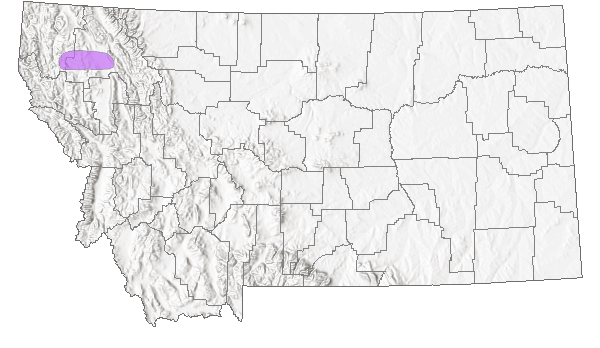
 Native
Native
Range Comments
Widespread in e WA, in the lower Clearwater River region of ID, MT, ne NV, n UT, s WY south to w TX and s AZ (Hitchcock et al. 1969). Known from Flathead County in Montana (Lesica 2012).
(P. Lesica's contribution adapted from Lesica et al. 2012. Manual of Montana Vascular Plants. BRIT Press. Fort Worth, TX)
Observations in Montana Natural Heritage Program Database
Number of Observations: 9
(Click on the following maps and charts to see full sized version)
Map Help and Descriptions
Relative Density
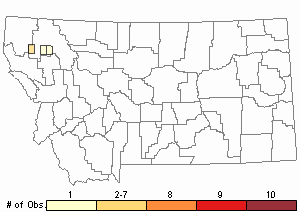
Recency
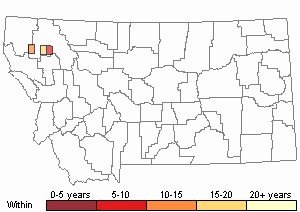
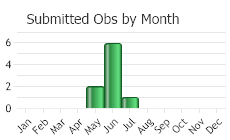
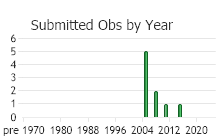
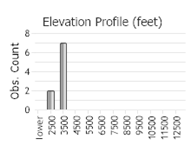 (Observations spanning multiple months or years are excluded from time charts)
(Observations spanning multiple months or years are excluded from time charts)
Habitat
Moist open slopes, meadows, or stream banks in mountains; 200--4000 m (FNA 2002). For Montana: Valleys and grasslands that are moist in spring in Flathead County (Lesica 2012).
(P. Lesica's contribution adapted from
Lesica et al. 2012. Manual of Montana Vascular Plants. BRIT Press. Fort Worth, TX)
National Vegetation Classification System Groups Associated with this Species
Grassland
Lowland - Prairie Grassland
Montane - Subalpine Grassland
Ecology
POLLINATORS The following animal species have been reported as pollinators of this plant species or its genus where their geographic ranges overlap:
Bombus bifarius,
Bombus centralis,
Bombus flavifrons,
Bombus huntii,
Bombus melanopygus,
Bombus sylvicola,
Bombus occidentalis, and
Bombus bohemicus (Macior 1974, Thorp et al. 1983, Colla and Dumesh 2010, Koch et al. 2012, Miller-Struttmann and Galen 2014, Williams et al. 2014).
Reproductive Characteristics
Flowers: Tepals 5-7 mm in length (Lesica 2012), ovate to lanceolate, blunt to acuminate, often with tiny teeth on margin and a papillate midrib, erect, pink to white, hardening to permanently envelope the capsule. Stamens generally shorter than tepals. Ovary with 6 low (= 0.5 mm), rounded knobs next to style. Stigma entire to barely 3-lobed.
Fruit: Seeds shiny black (Hitchcock et al. 1969).
(P. Lesica's contribution adapted from
Lesica et al. 2012. Manual of Montana Vascular Plants. BRIT Press. Fort Worth, TX)
Economic Value
Native Alliums are used in garden borders and rockeries. They are seldom grown, however, because common ornamentals have more intensely colored or larger flowers (Hitchcock 1969; Cronquist 1977).
Old World species of Allium are grown in the United States for flavoring and food: the common onion (Allium cepa), garlic (A. sativum), leek (A. porrum), and chives (A. schoenoprasum) (Cronquist 1977). Native Allium species are used medicinally and for cooking to add flavor (Moerman 1998; Harrington 1967).
Management
ECONOMIC VALUE
Native Alliums are used in garden borders and rockeries. They are seldom grown, however, because common ornamentals have more intensely colored or larger flowers (Hitchcock et al. 1994; Cronquist et al. 1994).
Old World species of Allium are grown in the United States for flavoring and food: the common onion (Allium cepa), garlic (A. sativum), leek (A. porrum), and chives (A. schoenoprasum) (Cronquist et al. 2004). Native Allium species are used medicinally and for cooking to add flavor (Moerman 1998; Harrington 1967).
Stewardship Responsibility
Threats or Limiting Factors
STATE THREAT SCORE REASON
Threat impact not assigned because threats are not known (MTNHP Threat Assessment 2021).
References
- Literature Cited AboveLegend:
 View Online Publication
View Online Publication Colla, S.R. and S. Dumesh. 2010. The bumble bees of southern Ontario: notes on natural history and distribution. Journal of the Entomological Society of Ontario 141:39-68.
Colla, S.R. and S. Dumesh. 2010. The bumble bees of southern Ontario: notes on natural history and distribution. Journal of the Entomological Society of Ontario 141:39-68. Cronquist, A., A. H. Holmgren, N. H. Holmgren, J. L. Reveal, and P. K. Holmgren. 1977. Intermountain flora: Vascular Plants of the Intermountain West, U.S.A. Volume 6: The Monocotyledons. New York, NY: Columbia University Press. 584 pp.
Cronquist, A., A. H. Holmgren, N. H. Holmgren, J. L. Reveal, and P. K. Holmgren. 1977. Intermountain flora: Vascular Plants of the Intermountain West, U.S.A. Volume 6: The Monocotyledons. New York, NY: Columbia University Press. 584 pp. Flora of North America Editorial Committee. 2002. Flora of North America North of Mexico. Vol. 26. Magnoliophyta: Liliidae: Liliales and Orchidales. New York, NY: Oxford Univ. Press. xxvi + 723 pp.
Flora of North America Editorial Committee. 2002. Flora of North America North of Mexico. Vol. 26. Magnoliophyta: Liliidae: Liliales and Orchidales. New York, NY: Oxford Univ. Press. xxvi + 723 pp. Harrington, H.D. 1967. Edible native plants of the Rocky Mountains. Albuquerque, NM: University of New Mexico Press. 392 p.
Harrington, H.D. 1967. Edible native plants of the Rocky Mountains. Albuquerque, NM: University of New Mexico Press. 392 p. Hitchcock, C. L., A. Cronquist, M. Ownbey, and J. W. Thompson. 1969. Vascular Plants of the Pacific Northwest. Part I: Vascular Cryptogams, Gymnosperms and Monocotyledons. Seattle, WA: University of Washington Press. 914 pp.
Hitchcock, C. L., A. Cronquist, M. Ownbey, and J. W. Thompson. 1969. Vascular Plants of the Pacific Northwest. Part I: Vascular Cryptogams, Gymnosperms and Monocotyledons. Seattle, WA: University of Washington Press. 914 pp. Koch, J., J. Strange, and P. Williams. 2012. Bumble bees of the western United States. Washington, DC: USDA Forest Service, Pollinator Partnership. 143 p.
Koch, J., J. Strange, and P. Williams. 2012. Bumble bees of the western United States. Washington, DC: USDA Forest Service, Pollinator Partnership. 143 p. Lesica, P., M.T. Lavin, and P.F. Stickney. 2012. Manual of Montana Vascular Plants. Fort Worth, TX: BRIT Press. viii + 771 p.
Lesica, P., M.T. Lavin, and P.F. Stickney. 2012. Manual of Montana Vascular Plants. Fort Worth, TX: BRIT Press. viii + 771 p. Macior, L.M. 1974. Pollination ecology of the Front Range of the Colorado Rocky Mountains. Melanderia 15: 1-59.
Macior, L.M. 1974. Pollination ecology of the Front Range of the Colorado Rocky Mountains. Melanderia 15: 1-59. Miller-Struttmann, N.E. and C. Galen. 2014. High-altitude multi-taskers: bumble bee food plant use broadens along an altitudinal productivity gradient. Oecologia 176:1033-1045.
Miller-Struttmann, N.E. and C. Galen. 2014. High-altitude multi-taskers: bumble bee food plant use broadens along an altitudinal productivity gradient. Oecologia 176:1033-1045. Moerman, D.E. 1998. Native American ethnobotany. Portland, OR: Timber Press, Inc. 927 p.
Moerman, D.E. 1998. Native American ethnobotany. Portland, OR: Timber Press, Inc. 927 p. MTNHP Threat Assessment. 2021. State Threat Score Assignment and Assessment of Reported Threats from 2006 to 2021 for State-listed Vascular Plants. Botany Program, Montana Natural Heritage Program, Helena, Montana.
MTNHP Threat Assessment. 2021. State Threat Score Assignment and Assessment of Reported Threats from 2006 to 2021 for State-listed Vascular Plants. Botany Program, Montana Natural Heritage Program, Helena, Montana. Thorp, R.W., D.S. Horning, and L.L. Dunning. 1983. Bumble bees and cuckoo bumble bees of California (Hymenoptera: Apidae). Bulletin of the California Insect Survey 23:1-79.
Thorp, R.W., D.S. Horning, and L.L. Dunning. 1983. Bumble bees and cuckoo bumble bees of California (Hymenoptera: Apidae). Bulletin of the California Insect Survey 23:1-79. Williams, P., R. Thorp, L. Richardson, and S. Colla. 2014. Bumble Bees of North America. Princeton, NJ: Princeton University Press. 208 p.
Williams, P., R. Thorp, L. Richardson, and S. Colla. 2014. Bumble Bees of North America. Princeton, NJ: Princeton University Press. 208 p.
- Additional ReferencesLegend:
 View Online Publication
View Online Publication
Do you know of a citation we're missing? Choi, H.J. and J.H. Cota-Sánchez. 2010. A taxonomic revision of Allium (Alliaceae) in the Canadian prairie provinces. Botany 88(9):787-809.
Choi, H.J. and J.H. Cota-Sánchez. 2010. A taxonomic revision of Allium (Alliaceae) in the Canadian prairie provinces. Botany 88(9):787-809. Lesica, P., M.T. Lavin, and P.F. Stickney. 2022. Manual of Montana Vascular Plants, Second Edition. Fort Worth, TX: BRIT Press. viii + 779 p.
Lesica, P., M.T. Lavin, and P.F. Stickney. 2022. Manual of Montana Vascular Plants, Second Edition. Fort Worth, TX: BRIT Press. viii + 779 p.
- Web Search Engines for Articles on "Geyer's Onion"





